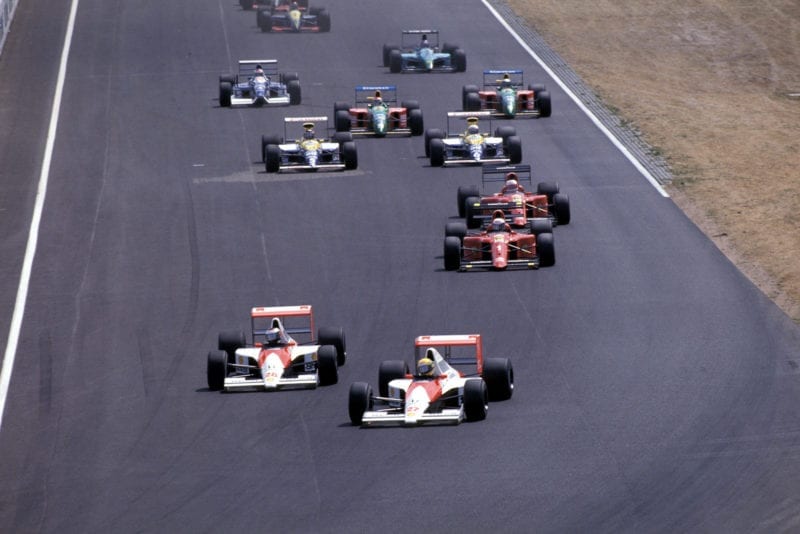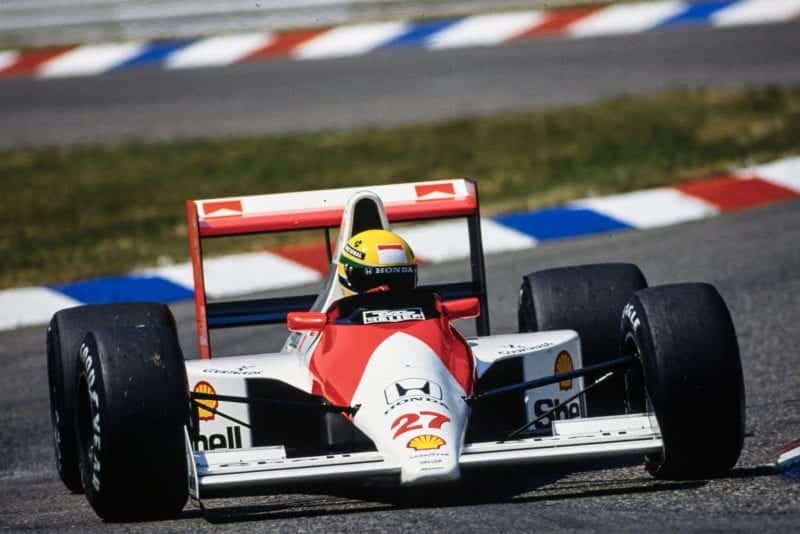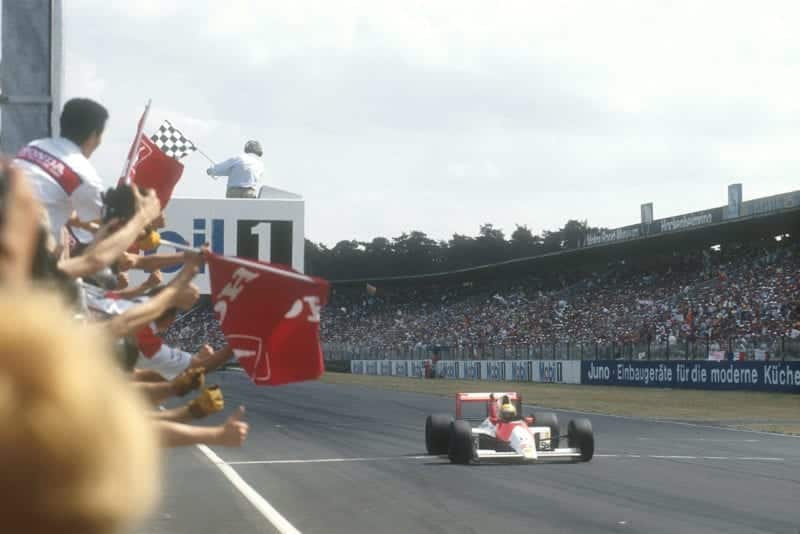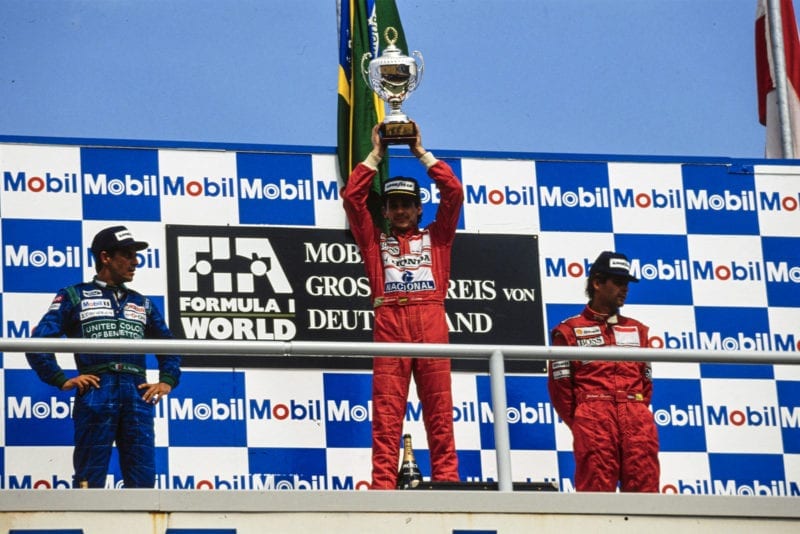Recovery
You can get used to anything, given time, and the Grand Prix world seems to have become used to the German Grand Prix being held for Formula One at the fast but dull Hockenheimring. At one time the mere name of Das Grosser Pries von Deutschland struck fear into the hearts of the timid, apprehension into the bravest of drivers, for it was held every year on the mighty Nürburgring, the 14 mile circuit in the Eifel mountains overlooked by the medieval castle high above the village of Nürburg. It was the scene of great feats of driving and many deeds of derring-do, legends abounded and the superstitious saw ghosts in the dense forests through which the circuit wound its way.
In 1959 the German Grand Prix was used as a political tool and it took place on the AVUS circuit on the edge of Berlin, but it was a bit of a flop and nobody wanted to go back; in fact, they could not get back to the mighty Nürburgring quick enough. Over a period of time the ‘improvers’ and `do gooders’ who do so much to help Grand Prix racing (!) destroyed the Nürburgring as a Grand Prix circuit and forced the move south to the Hockenheimring. A New Nürburgring was built and Formula One paid it one fleeting visit and then settled back comfortably in the fast but dull Hockenheimring.
The years have passed and it is likely that none of today’s Formula One drivers are aware that there was anything before the Hockenheimring and in Formula One parlance the race is The German Grand Prix, not Das Grosser Preis von Deutschland. You can get used to anything, given time.

The McLaren pair fight for the lead at the start of the German Grand Prix
Motorsport Images
After the British Grand Prix at Silverstone, where the combination of Honda/McLaren/Senna were well and truly beaten there was a lot of serious thinking and planning behind the scenes and Honda produced what they described as a more powerful and higher revving version of their V10 engine, while McLaren honed their aerodynamics more finely. Senna did not need any work done on himself, for losing is not in his vocabulary, and ‘beaten’ is a word he does not understand.
Some pre-race testing soon indicated that McLaren-Honda had taken a firm hold of the situation, and it only needed the Friday afternoon qualifying for everything to be back to where it used to be. McLarenHonda first and second in the tidy order, Senna-Berger, but it had not been all plain sailing for Berger’s car had died on him in morning testing, with another malfunction in the engine throttle system. It was not a simple broken cable or a link falling off somewhere, it was an electronic malfunction, to which the more inquisitive said ‘Electronics in the throttle system? How interesting’ but the conversation stopped there. The Ferrari-Fiat team were still the main opposition, though they were over a second slower than the McLaren-Hondas, and after the show of Fiat strength at the previous two races, with each of their drivers having a ‘qualifying’ car and a ‘race’ car, they now reverted to the more orthodox arrangement of each driver having his own car, with one spare car designated to the number one driver and an adequate supply of engines for both.
There were no real embarrassments to the scene as we have come to know it by mid-season, and the Benettons were split by Alesi in the Hart-powered Tyrrell, more to the chagrin of Cosworth and Ford than to Benetton. Without the intrusive Jean Alesi in the slippery Tyrrell the list would have looked neat and tidy, and rather dull. Two McLaren-Hondas, two Ferraris, two Benetton-Cosworths and two Williams-Renaults, all neatly lined up in pairs, which would indicate that the Hockenheimring does not allow for driving prowess to shine through. Even so, mistakes can be made and Alessandro Nannini made a good one going into the third chicane clipping a kerb and launching the Benetton into the air and off into the guard-rail, virtually destroying the car and putting a stop to qualifying. This was before the front runners had done their second qualifying runs, and though qualifying was restarted it was difficult to pick up the rhythm again with the accident scene still a bit slippery, so no serious improvements were made. Nannini being completely unscathed was able to get back into the swing of things using the Benetton T-car, while plans were in motion to have a new monocoque shipped from England overnight.
If the accident had not upset this first qualifying it is quite likely that the heat would have done, for the air within the concrete stadium was heating up to unbearable proportions, but there was worse to come. Saturday was even hotter and heavier and it seemed that a thunderstorm must come, but it didn’t and the atmosphere became more and more oppressive. As is normal any team that was well under control spent the morning searching out the ideal set-up for the race, while some were still trying to find a set-up that would work, let alone go fast! Senna’s provisional pole-time from Friday was 1 min 40.198secs, an average speed of 151.744 mph and both he and Berger had topped the 200 mph mark on the outward run from the Stadium. I seem to recall that this new 3 1/2-litre Formula and the banning of turbochargers was supposed to be slowing things down. It was also going to make things more equal for everyone, though I never understood how it was going to do that. The tail-enders were struggling to reach 190 mph, which seems pretty fast for a hopeless team that fails to qualify. In times for the lap, the difference between the first and the last was over 8 seconds, and 8 seconds at an average speed of 150 mph is a long, long way behind.
As it was clear that the conditions were too hot for anyone to approach the McLaren times of Friday, Senna and Berger concentrated on searching for an optimum race set-up, running on relatively hard race tyres and with lots of fuel on board. Their times, while not spectacular in a qualifying session were such that they had eight drivers behind them running in full qualifying trim! Mansell, Patrese and Boutsen had not gone their quickest on Friday and were able to improve on Saturday, which moved them a bit closer to the front of the grid. It is interesting that Berger topped 199 mph in race trim and Boutsen and Senna clocked 198 mph, and while some teams tried all they knew on qualifying tyres for one searing lap, the McLarens were going round and round, Senna covering 22 laps all told during the qualifying hour. The Honda engine men were doing some close monitoring of all the systems, for that morning Senna had come walking to the pits, his engine having died due to an electronic fault.

Senna side-by-side with Alessandro Nannini
Motorsport Images
In the Benetton pits work was in full swing to build a new car around a virgin monocoque that had arrived from the factory overnight, the aim being to have it finished in time for the Sunday morning warm-up session. In the meantime Nannini was using the T-car. At the lower end of the grid the scene for pre-qualifying had changed slightly, in that the Larrousse Lola-Lamborghinis no longer had to prove they were capable of qualifying halfway up the grid before the meeting really started, and their place was taken by the Ligier team, the pre-qualifiers who went home on Friday morning before anything serious began remained more or less unchanged.
On race morning in the half-hour warm-up session two interesting things emerged; one was that Ferrari looked like giving McLaren a good run for their money, and the other was the fact that Berger, Prost, Boutsen and Senna all clocked over 200 mph through the speed trap which suggested that power and speed were all important, even though lap times were down the normal 4 to 5 seconds on qualifying lap times.
It is reasonable to assume that anyone worth calling a serious Formula One driver should be in the front half of the grid, or for that matter any team calling itself a serious Formula One team should have cars that can make the front half. McLaren, Ferrari, Williams and Benetton are expected to be up the front, but the scene is taking on a fairly regular appearance with the Tyrrells, the Lola-Lamborghinis and the Leyton House-Judds monopolising the second division, with the Lola drivers Suzuki and Bernard impressing on more than one occasion. Those at the back of the grid seemed destined to stay there, for in spite of what people say, engines and power are all important and it is fast becoming obvious that if your team has not got the backing of an engine manufacturer and their research and development department, you are not only not going to make any progress, but you are not going to keep up with the ever increasing pace of the top teams; unless, of course, you have a Jean Alesi driving for you.
An accident in one of the supporting races caused it to be stopped and cancelled, and this left a bit of a gap in the day’s proceedings before the Formula One cars came out of the pit lane to start the dummy-grid assembly ritual. What air there was in the Hockenheimring stadium was not only very hot, but it felt heavy and there was a haze over the sun that made the scene a bit oppressive. With the exception of Modena who had to change from his race-car with the transverse transmission to the T-car with the old transmission, at the last moment, everyone seemed to be in fair order, though a number of teams were still undecided about the tyre situation, leaving it to the intelligence of their drivers to assess the situation in the opening phase, but everyone was prepared for pit stops for new tyres at some point in the race. The Benetton team had done an excellent job in building up a new car for Nannini, which had performed well in the warm up and he was on the grid behind his team leader and full of confidence.
The Hockenheimring does not generate much in the way of excitement by its very nature, though the start is always an impressive scene, especially for those in the grandstands overlooking the starting grid. You are high above the track, with an almost aerial view and the rush to the first corner is always impressive. To many the exit of the fast right-hander is out of sight, so once the leaders have disappeared, often side by side, it is a matter of waiting just over a minute to see who appears first back into the stadium at the far end. It is not a scene that gets the adrenalin flowing, but it is interesting. While everyone watched Senna and Berger lead the pack into the first corner a dicey moment at the back of the grid almost went unnoticed.
Stefano Modena’s clutch played up and he crept away causing David Brabham to be slow off the mark when the green light shone, which caused Pirro to ride his Dallara up over the back of Brabham’s car and spin across the track and thump backwards into the Armco barrier. As it did this it nearly collided with Alliot’s Ligier but the Frenchman took avoiding action and came to rest with a stalled engine. While many people were expecting red flags to stop the race, the race director was quick to assess the situation and make the decision that the race would continue. Alliot’s Ligier had been push-started by the marshals and he had set off after the 24 cars that had gone, and the wrecked Dallara was well off the racing line, and there were medical service cars on either side of the wrecked car. Amid a sea of waving yellow flags, preceded by stationary yellow flags before the pit straight, the race continued. The only unfortunate part was that Pirro had been knocked unconscious and the doctors and medical staff were having a bit of a problem getting him out of the car. The noise from 22 cars going by a few feet away (Modena had retired his Brabham on the opening lap with no drive to the rear wheels), followed by the lonely Ligier of Alliot going down the pitlane on the other side of the barrier was a bit disturbing for the rescue workers, but quite safe. Thinking Alliot was going to retire when he stopped in avoiding Pirro, a marshal had undone the Frenchman’s seat harness buckle, so a return to the pits was necessary to re-fasten it, but it was in vain because the 1990 rules were going to force his exclusion once the Stewards had sorted out the accident situation.
Eventually Pirro was extracted from the cockpit and lifted over the barrier into an ambulance and taken to the medical centre where he was found to be unhurt. The wrecked Dallara was towed off the track, the yellow flags put away and the race was on in earnest, which it had been anyway all round the rest of the circuit.

Senna out in front by himself on the way to a routine win
Motorsport Images
For McLaren-Honda enthusiasts it was Status Quo, with the team running first and second, with Senna leading Berger, followed by the two Ferraris, the two Williams-Renaults, the two Benettons and the two likely-lads’ Alesi and CapeIli. Boutsen upset this neat and tidy scene by having a quick spin on lap 3 and dropping back from 6th place to 10th place. In this first phase of the 45 lap race Senna was in total command, and gradually drew away from Berger, though the Austrian had the two Ferraris uncomfortably close behind, with Mansell getting agitated because Prost would not let him by!
The high-speed procession suddenly fell apart on lap 15 when both Berger and Prost decided they needed new tyres and peeled off into the pit lane. Mansell had gone off the road at one of the chicanes, and dropped behind Patrese, Nannini and Piquet and instead of charging through in hot pursuit the number two Ferrari peeled off into the pit lane and drove straight into the pit garage and out of the race. The reason given later was that the underside of the car had been damaged, though how Mansell knew this before he got out of the car was not explained. But Ferrari never explain anything to anyone. Mansell packed his things and was soon gone, but not before he had an unofficial whinge about Prost not letting him go by!
Senna now had a commanding lead, but two laps later he was in for tyres and as he exited the pit-lane he had to keep over to the right as Nannini went by into the lead, as he had taken second place from Patrese as Senna was preparing to stop. At the end of lap 19 Patrese stopped for tyres and then Alesi came in for a similar reason. He approached a bit too fast and slightly off line, due to other activity in the pit-lane, but displayed remarkable reflexes and decision-making. Unlike a lot of drivers who would have tried to stop and re-position the car and made a complete pigs-car of the job, Alesi did not hesitate and accelerated away down the pit-lane to go round for another lap and make a proper job of the stop next time round. The whole affair lost him about 8 seconds and was a brilliant display of coolness and quick thinking. It is things like that that make you watch some of the new boys.

McLaren celebrates as Senna crosses the line to win
Motorsport Images
Alessandro Nannini was revelling in his inherited lead, and the Benetton team were smiling quietly to themselves for they had no intention of stopping their cars for new tyres, and Piquet was safely in 3rd place, though Berger was closing up on him. Senna was clearly biding his time about trying to retake the lead, having found that the Benetton was too quick along the straight for the Honda simply to power past. He closed right up on lap 24, but then dropped back and followed at a discreet distance, fully aware that the Benetton was going to go through non-stop, but knowing that before the end of the race his McLaren would be in a better condition as far as the rubber was concerned. The outcome was a foregone conclusion, the only interest lay in when would Senna swoop in for the kill. Nobody begrudged Nannini his moment of glory, or the Benetton team, just as there had been pleasure at the French Grand Prix when Capelli had lead for Leyton House.
The Benetton fortunes took a slight knock on lap 24 when Piquet’s engine failed, but Nannini still looked and sounded strong. It was now Benetton, McLaren, Ferrari, Williams and the only possible change that could be anticipated was up to Senna. Berger in third place was comfortably ahead of Prost, but losing ground to the leaders, while Patrese seemed settled in fifth place. Boutsen in the second Williams should have been in sixth place, but a wheel baulked going back on the hub during his tyre stop and the delay dropped him down to 9th.
On lap 33 as Nannini came into the stadium wiggles he was about to lap Lehto’s Monteverdi and Senna saw his opportunity. As the Benetton slowed slightly, before passing the blue and white Swiss car, Senna had his nose right up the tail of the Benetton, and went by with it. He was still right in the slipstream leaving the stadium, and under braking for the first chicane he was by and into the lead. It was all over, and Nannini’s moment of truth and glory had come to an end, but not with any remorse for he had stayed ahead valiantly and without getting rattled though he was not as neat and tidy through the chicanes as one would have liked to have seen. When Senna is behind you there is a tendency to see him in both of your mirrors at the same time, which must be very unnerving.
Senna cruised quietly home to a very confident win, but his team-mate did not back him up with a strong second place, as was expected by Honda and McLaren, though he did hold on to his third place. Afterwards he said that he felt that his engine was not as good as it could have been. As he put it, ‘My engine was not of the best’ not as a criticism but as a statement of fact. One seasoned French journalist commented that if that statement had come from Senna’s team-mate of last year it would have been a ‘whinge; coming from Berger it was a simple and honest opinion, because Berger is that sort of chap. Unfortunately the record book will only give the bald statement of fact that Berger (McLaren-Honda) was 3rd, behind Alessandro Nannini (Benetton-Cosworth V8). It won’t look too good on his CV at the end of the season.

Senna holds the first place trophy aloft
Motorsport Images
At Silverstone the McLaren-Honda team went home thinking ‘This won’t do’ and full of determination to sort things out, this time the Ferrari team went home thinking ‘That wasn’t very good’ but there wasn’t an air of determination about the red team. The Benetton team were on a high, as the MkIV Cosworth EXP and the efficient B190 chassis was performing impressively well and they could smell the possibility of a resounding victory before the end of the season.
The Tyrrell team had not expected to do wondrous things on such a fast and easy circuit, but had not been disappointed while the cars were running. The disappointment came when Nakajima’s engine gave trouble and Alesi went out with a broken drive-shaft universal joint. When you have a driver like Alesi in the cockpit everything needs to be extra strong, not because he is hard on a car, but because he can use everything you give him and is always ready to use a bit more. The Williams-Renault team in finishing 5th and 6th showed once again that they are front runners, but they badly need a Senna or Prost to lead them and there aren’t any spare ones on the market. The two Lola-Lamborghinis of the Larousse team had run strongly as high as 7th and 8th places, but both were forced out before the end, Suzuki with clutch failure and Bernard with a loss of fuel pressure. Of the other Lamborghini-powered team Donnelly went out with clutch failure before the race got properly under way and Warwick finished in 8th place, one lap behind the winner. His tactful comment that ‘the car was rather difficult to drive. ..blistering its tyres and jumping around a lot, giving me double-vision for most of the race…’ makes it sound rather evil.
As usual the Ferrari-Fiat publicity department made no comments at all about anything, so one can only go on what the drivers say and with Mansell disappearing quickly in the wake of a ‘whinge’ and Prost mumbling on about this and that, without saying anything positive one can only assume that Ferrari were well and truly beaten this time. DSJ
